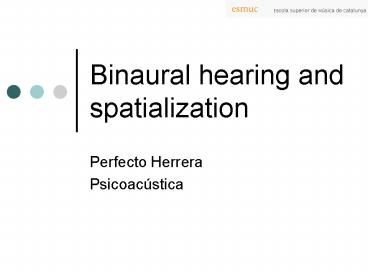Binaural hearing and spatialization
1 / 25
Title:
Binaural hearing and spatialization
Description:
Binaural hearing and spatialization Perfecto Herrera Psicoac stica La natura ha prove t l sser hum amb una llengua, per amb dues orelles, de manera tal que ... –
Number of Views:186
Avg rating:3.0/5.0
Title: Binaural hearing and spatialization
1
Binaural hearing and spatialization
- Perfecto Herrera
- Psicoacústica
2
- La natura ha proveït lésser humà amb una
llengua, però amb dues orelles, de manera tal que
pugui escoltar dues vegades més que parlar - Zenó
3
Why 2 ears?
- Locating sounds in space acuity is poorer than
in vision by up to two orders of magnitude, but
extends in all directions. Role in alerting and
orienting? - Separating sound sources signals from 2
receivers can be compared and operated on to
enhance the reception of one sound source over
another. The same applies to signals in a
reverberant environment. - Definitions
- Monaural Sound presented to one ear
- Binaural Sound presented to both ears
- Diotic Sounds identical at the two ears
- Dichotic Sounds different at the two ears
- Azimuth position in the left-right axis
- Elevation position in the up-down axis
- Blauert, J. (1997). Spatial Hearing The
Psychophysics of Human Hearing. Cambridge, MA
MIT Press.
4
Localisation in 3 dimensions
- Azimuth (left/right)
- (Arab. as-sumut, i.e. as al the sumut, pl of
samt way) - Binaural cues Interaural Time Differences and
Interaural Level Differences - Lateralization is a simplified localisation
(placement in the head) - Median-plane (front, up, back, down)
- Pinna-induced spectral cues
- Head movements
- Distance
- Absolute level, Inverse-square law (intensity
decreases 6dB each time we double the distance),
spectral balance, reverberation
5
Anatomy of the auditory system
6
Interaural Level Difference (ILD)
From David McAlpine
Processed in Lateral Superior Olive
7
(No Transcript)
8
ILD is greater for higher frequencies
Interaural level differences calculated for a
source in the horizontal plane. The source is at
an azimuth q of 10 (green curve), 45 (red), or
90 (blue) relative to straight ahead. The
calculations assume that the ears are at opposite
poles of a rigid sphere.
9
Interaural Time Difference (ITD)
From David McAlpine
Processed in Medial Superior Olive
10
Interaural time-difference - ITD
t R
t L
ITD t R - t L
Maximum c 0.6 ms
11
(No Transcript)
12
(No Transcript)
13
Phase Ambiguity
This particular case is not a problem since max
ITD 0.6 ms But for frequencies above 1500 Hz it
IS a problem
14
Phase Ambiguity
Both possible times are less than the maximum ITD
of 0.6 ms
15
Raleighs Duplex theoryfor pure tones
- Low frequency pure tones (lt1500 Hz) localised by
interaural time differences - High frequency pure tones localised by intensity
differences
16
Raleighs Duplex theoryfor pure tones (2)
- 1. Low frequency tones (lt1500 Hz) localised by
phase differences - Very small interaural intensity difference for
low-frequency tones. - Phase locking present for low frequency tones
(lt4kHz).
17
Raleighs Duplex theoryfor pure tones (2)
- 1. Low frequency tones (lt1500 Hz) localised by
phase differences - Phase locking present for low frequency tones
(lt4kHz). - Limited by phase ambiguity Maximum ITD 670 µs
corresponding to a whole cycle at 1500 Hz (the
upper limit for binaural phase sensitivity)
18
Raleighs Duplex theoryfor pure tones (3)
- High (and close low) frequency tones localised by
intensity differences - Shadow cast by head greater at high (20 dB at 6
kHz) than low frequencies (3 dB at 500 Hz) i.e.
head acts as a lowpass filter. - For close sounds (lt1.5m) the inverse square law
gives intensity differences between the ears for
all frequencies. These differences vary with
azimuth independently of any head-shadow effect.
Beyond 1.5m the difference in level between the
ears due to this factor is less than 1 dB.
19
(No Transcript)
20
Pinna notch
21
Head-Related Transfer Functions
22
(No Transcript)
23
Precedence (or Haas) effect
Reflections arriving in the 0-40ms range are
linked to the direct sound source Longer delays
are detached from the direct sound source and
considered echoes
24
Applications of the precedence effect
25
Perception of distance
- More distant sounds are
- Quieter (inverse-square law)
- More muffled (high frequencies dont travel so
well) - More reverberant (direct is quieter relative to
reflected)
For very close sounds, the difference in distance
from the source to the two ears becomes
significant -gt excess IID from inverse-square law.
26
Perception of distance































